Subscribe now to get notified about IU Jharkhand journal updates!
Effectiveness of Work Life Balance : A Study of Management Teachers
Abstract :
Family and work are the two important points in the life of an adult. The combination of work and life, known as work life balance, has become an important aspect of the current academic debate (Eikhof, Warhurst, & Haunschild, 2007). A better balance between work and life is an issue for everyone. It is strongly believed that maintaining a balance between career and personal or family life can be challenging and impact an individual's satisfaction in his work and personal life roles (Broers, 2005). It has been observed that work life balance provides for the balanced relationship among work, non- work and family aspects of life. If the work-life is good, the functioning of the organization will also be in a smooth and proper manner. This paper therefore focuses on an in-depth look at work life balance considering in view that balance in work and family life is an emerging challenge for both employees and employers. For this study primary data were collected with the help of a structured questionnaire by using convenience sampling of 200 teachers in management education institution. Secondary data were collected from earlier research work, various published journals, magazines, websites and online articles.
Keywords :
Work life balance, management teachers, employee, stress, stress managementIntroduction :
For the past two decades, it has been observed that worklife
balance as well as the need for “good work-life
balance” has featured prominently in countless
academic, practitioner and policy maker debates
(Fleetwood, 2007; MacInnes, 2008). Work-life balance is
the degree to which an individual is able to
simultaneously balance the temporal, emotional, and
behavioral demands of both paid work and family
responsibilities (Hill et al., 2001, p. 49). It is a situation in
which employees are able to give the right amount of
time and efforts to their work as well as their
personal life outside work (Work-life balance, 2009.
Anna, B., 2010). Work-life balance is achieved when an
individual's right to have a fulfilled life inside and
outside work is accepted and respected as the norm,
to the mutual benefit of the individual, business and
society'. Work-life balance refers to the flexible working
arrangements that allow both parents and non-parents to
avail of working arrangements that provide a balance
between work responsibi l i t ies and personal
responsibilities.
The teaching faculty members are the facilitators of
knowledge and skill through interactive learning
methods in management education. Fast changing
educational process in the present century has influenced
the role of teaching professionals, their responsibilities
and teaching activities at management institutes. As a
result, they may face “stress in their day to day life through
common work and non work stressors, ultimately
lowering down their psychological well being. Along with
teaching, a faculty member has to perform varied other
duties such as doing administrative jobs, attending faculty
meetings, advising students, guiding project work,
internship, summer placement of students, conducting
exams, doing assessment and undergoing faculty
advancement schemes. In present times, young teaching
professionals are increasingly confronted with a problem
of conflict between work role and an equally demanding
role at home. An understanding of stress in management
teaching professionals may not only form the basis of
stress analysis but may also be useful in rationalizing
stress behaviour and formulating coping strategies for the
entire teaching population.
Review of Literature :
Jackson, Schwaband Schuler (1986), said that work role stress is a common stressor among professionals. “Occupational stress in teaching has been found resulting in both mental and physical ill health, ultimately having deleterious effect on teacher's professional efficiency.” Camp (1985) observed that though researchers have identified stressors for teacher groups in specific teaching contexts but there is notable absence of research in Indian context. Telschow (1990) was inspired to know effect of stress on health and ways of coping with stress among these teachers. Claxton (1989), through his investigation sought to identify major sources of stress in management professionals and conceptualized three basic premises. French (1988), found that the effects of stress are influenced by gender and length of service. Various personal, family and situational factors are responsible for stress.
Statement of Problem :
Teaching faculty members may experience role stress because of multiple roles they play in society. The conflict between work and family demands may all put a strain on the teaching faculty members. Much of the earlier researches on stress have focused on managerial and professional groups but tend to neglect occupations related to teaching. These multiple roles of teaching professionals constantly keep them under pressure and lead to imbalance in their work and personal life. In order to understand the reciprocal relationship between the three variables namely Stress- effects, roles stressors and job satisfaction, this study was planned.Research Objectives :
- To identify the effects of stress experienced by faculty members.
- To determine the causes of stress among management teachers.
- To measure the extent of job satisfaction related to family role stressor and work role stressors.
- To understand the relationship between stress-effects and job satisfaction.
Hypotheses Formulation :
H01 There is a significant influence of service duration on
the extent of stress-effects experienced by management
teachers.
H02 There is a significant difference in the extent of stress-
effects experienced by management teachers based on
personal factors, family factors and situational factors.
Variables :
Two sets of variables were selected for this study, namely
independent and dependent variables. The independent
variables were then again classified into two categories,
namely individual and job related variables. All the
variables under study were as follows:
I. Independent variables
- Individual factors (Personal factors, Family factors)
- Job related factors (Situational Factor, Service Duration, Role, Stressors, Job Satisfaction)
- Effects of Stress
Research Design :
The study was undertaken in the Varanasi district of Uttar Pradesh, India. The respondents were the faculty members working in the management colleges and selected using the Convenience Sampling method.
Data Collection and Findings :
A survey study method was adopted for the present study.
A total of 200 questionnaires were used as an instrument
for gathering data from 15 management institutes. The
data collection period fell between September to
November 2016.
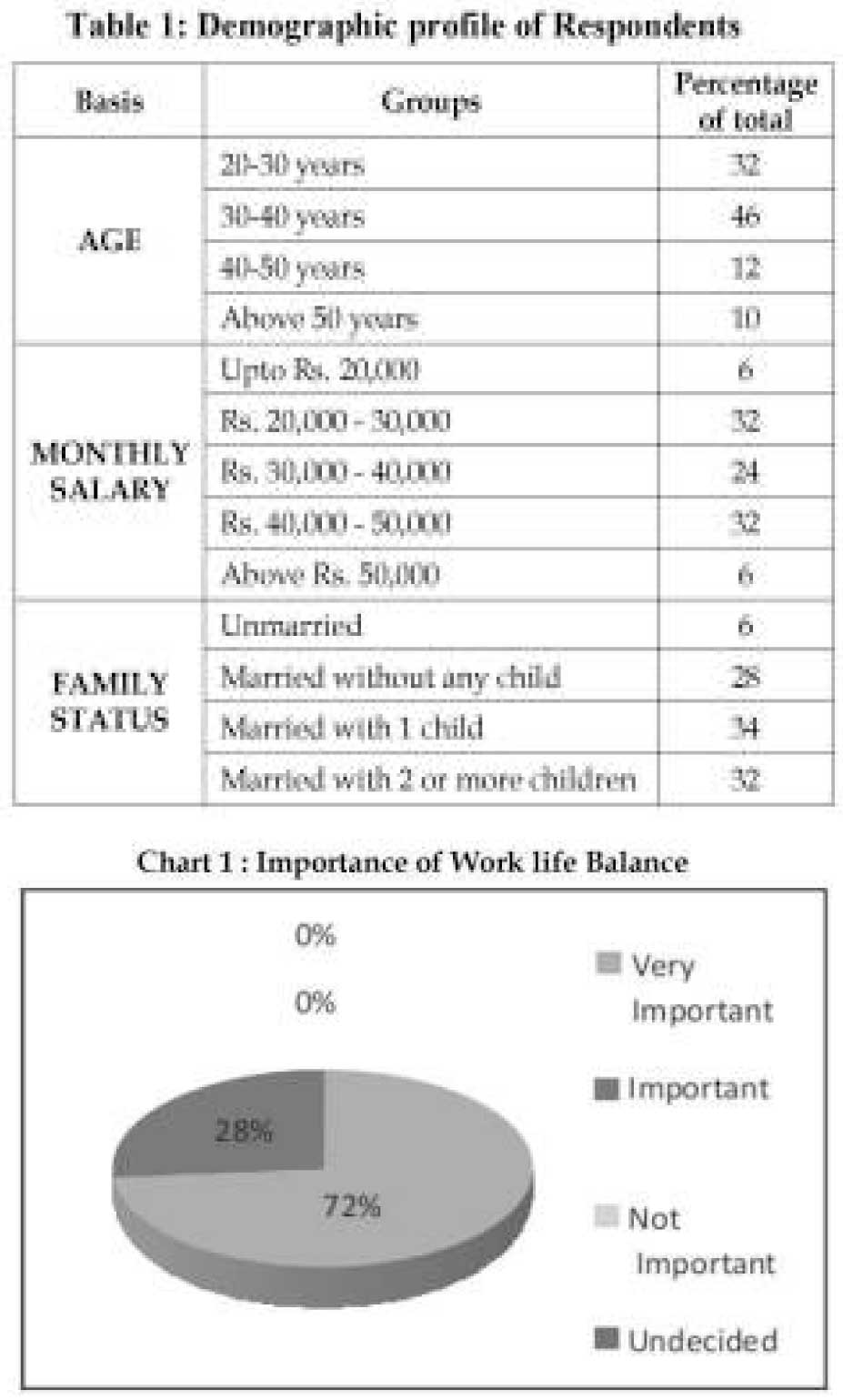
72% respondents felt that it is very important and 28%
respondents felt that it is important to achieve work-life
balance. There were no respondents who were undecided
or who felt that it is not important to maintain a balance
between work and life. This is a very good sign since
considering work-life balance important is the first step
towards achieving it.
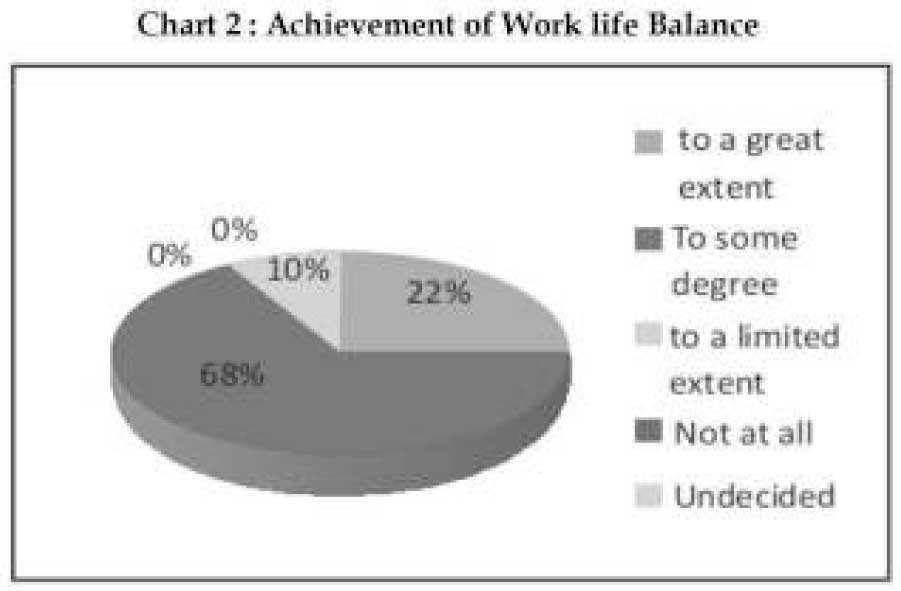
22% of the respondents said that they were able to achieve
work life balance to a great extent, 68% of the respondents
said that they were able to achieve work life balance to
some degree, whereas 10% respondents were undecided.
Thus, there were some respondents who were not sure
whether they are able to achieve work life balance or not.
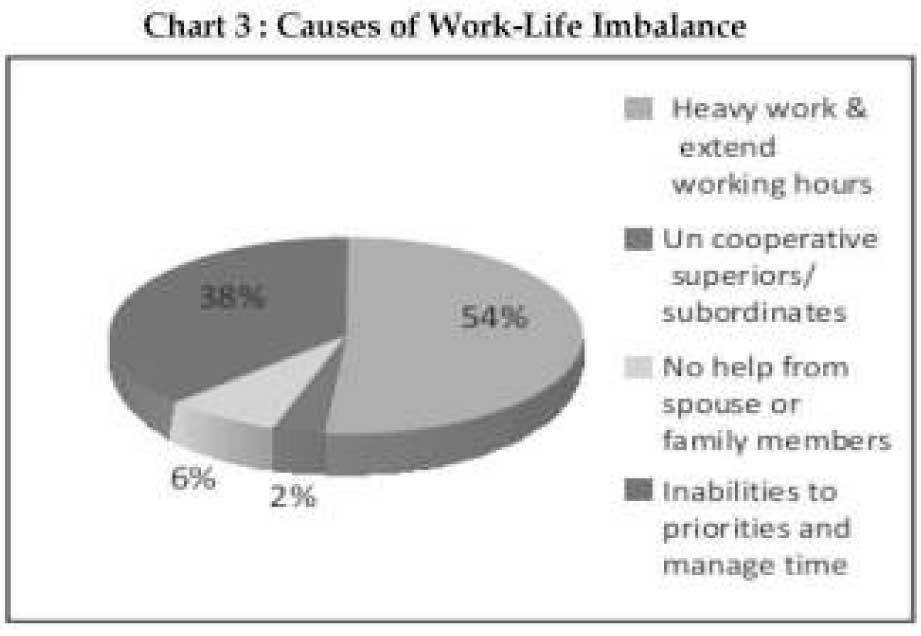
When asked about what they think are the possible causes
of work life imbalance, a whopping 54% respondent's
accounted heavy workload & extended working hours to
be responsible for work life imbalance. 38% respondents
said that inability to prioritize and manage time is the
cause for work life imbalance, 2% respondents felt that
uncooperative superiors and subordinates isthe reason
whereas only 6% said that according to them, no help from
spouse or family members is the reason for not being able
to balance between work and life. This shows that there is
fair amount of support provided by spouse and family
members to working women.

48% of the respondents said that they face stress
sometimes due to their inability to balance between work
and life, 32% said they are stressed occasionally and about
6% said they feel stressed lot of times. Thus about 86% of
the respondents agreed that they feel stressed at not being
able to achieve work life balance either lot of times,
sometimes or at least occasionally. Only 12% respondents
said that they are not stressed and 2 % chose not to
comment.
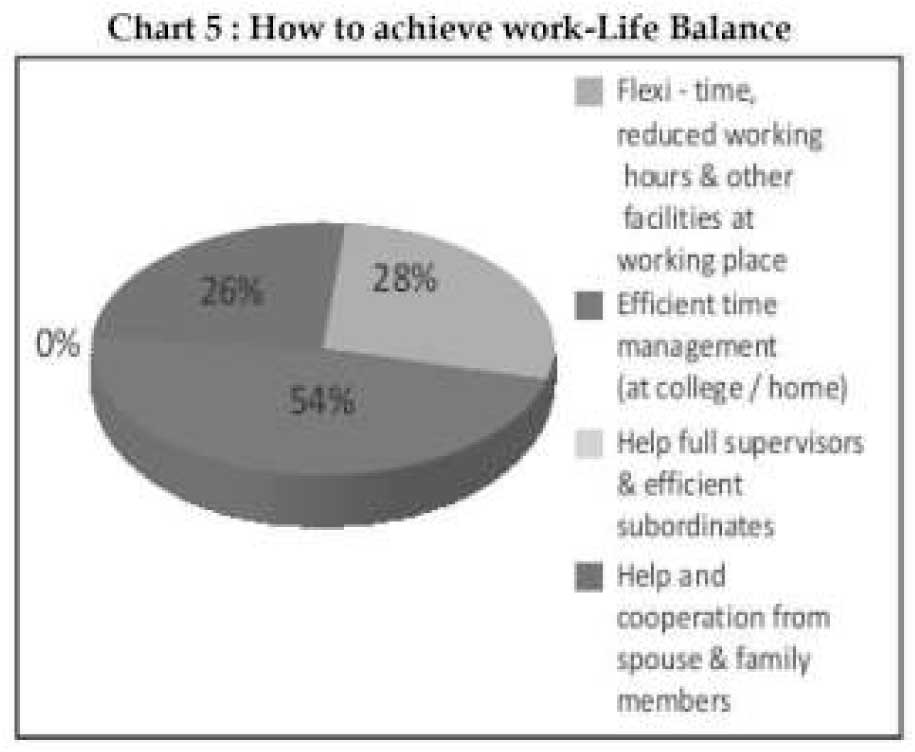
According to 46% of the respondents, efficient time
management (at college/home) is the key to achieving work life
balance. While 28% of the respondents said that flexi-time,
reduced working hours & other facilities at the workplace can
help to achieve work life balance, 26% of the respondents said
that help & cooperation from spouse & family members is
required.
Resultsand Discussion:
H01 There is no influence of service duration on the extent of
stress-effects experienced by management teachers.
H02 There is a significant difference in the extent of stress-effects
experienced by management teachers based on personal factors,
family factors and situational factors.
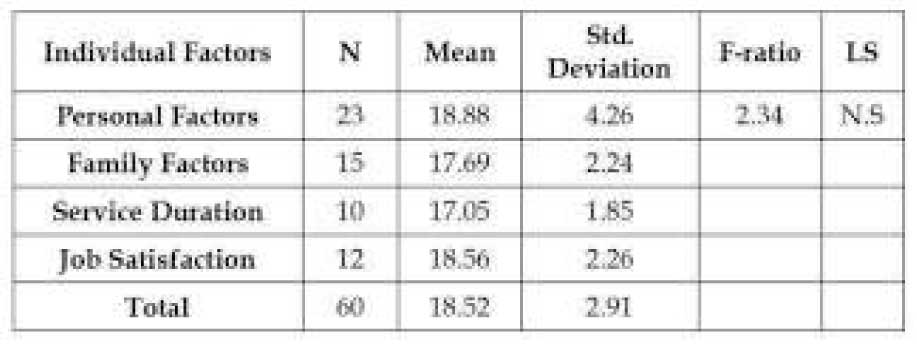
Source : Primary Data
Result :
Respondents do not differ significantly on
Individual factors. The result reveals that the obtained Fratio
(2.34) is not significant at 0.01 levels. Hence the stated
hypothesis is rejected. Therefore, respondents do not
differ significantly in their Work life balance on the basis of
Individual factors. For the influence of service duration on
stress effects, the null hypothesis was rejected. Therefore,
it can be said that service duration also affects the level of
stress experienced by the teachers.
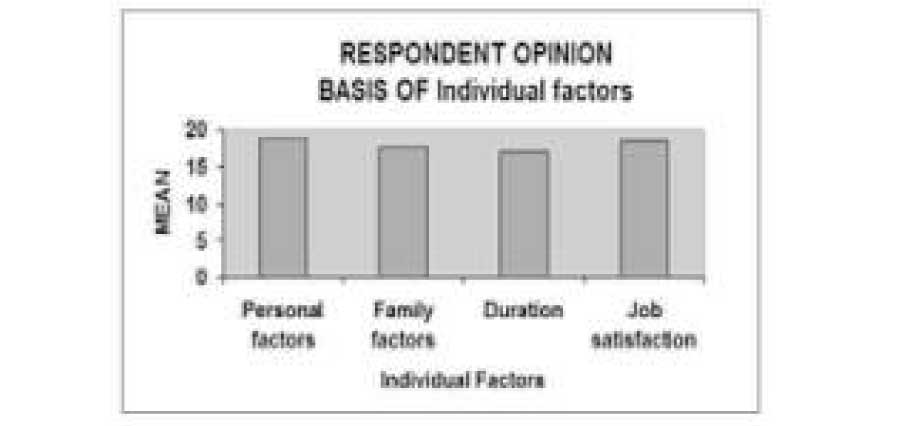
Fast changing educational process in the present century
has influenced the role of teaching professionals, their
responsibilities and teaching activities at management
institutes. As a result, they may face “stress in their day to
day life through common work and non work stressors,
ultimately lowering down their psychological well being.
Along with teaching, a faculty member has to perform
varied other duties such as doing administrative jobs,
attending faculty meetings, advising students, guiding
project work, internship, summer placement of students,
conducting exams, doing assessment and undergoing
faculty advancement schemes.
Other Important Observations :
- About 60% of the respondents feel that women in the both academics and corporate are equally stressed, reasons may be different.
- Close to 90% of the respondents feel that they are able to achieve work-life balance to a great extent or at least to some degree, but are found to experience many of the indicators/symptoms of work-life imbalance.
- Most of the visiting/part-time faculties admitted that they opted for a part-time/visiting job so that they could balance between their work & life.
Scope for Future Research :
The recommendations made by the researcher at the professional level can be given a due thought by the institutional heads. Then, as per the suitability of the needs and availability of resources, each institution can prioritize and implement these recommendations for minimizing stress in their faculty members these leads such a work life balance among women teachers in any educational institution.
References :
- Baral R. & Bhargava S., (2011). HR Interventions for Work-Life Balance: Evidences from Organizations In India, International Journal Of Business.Management And Social Sciences , 2( 1).
- Bhattacharya Soumya & Mehra Puja. (October 2010). Corporate Aparatheid. Business Today.
- Chang Artemis, McDonald Artemis &Burton Pauline, 2010.Methodological Choices In Work-Life Balance Research 1987 To 2006 : ACritical Review.TheInternational Journal Of Human Resource Management.
- Chawla Deepak & Sondhi Neena. (2011). Assessing Work-Life Balance among Indian Women Professionals, The Indian Journal Of Industrial Relations, 47( 2).
- Keith Davis. Organizational Behaviour. Tata McGraw Hill Publishing Company Limited, 11th Edition, 375- 376.
- Divya D, Suganthi L & Samuel Anand. A, (2010). Work Life Balance of IT Women Professionals belonging to the age Group 20-35 In India. Advances In Management, 3(1).
- Ilies Remus, Schwind Kelly Wilson, Wagner David T. (2009). The Spillover Of Daily Job Satisfaction Onto Employees' Family Lives: The Facilitating Role Of Work-Family Integration, Academy of Management Journal, 52(1)
- Kanwar Y. P. S, Singh A K & Kodwani A. D.(2009).Work–Life Balance And Burnout As Predictors of Job Satisfaction In The IT-ITES Industry. Vision- The Journal Of Business Perspective, 13(2).
- Karkoulian, Silva & Halawi Leila. (2007). Women And Work/Life Conflict At Higher Educational Institutions. International Journal of Business Research, VII(3).
- Kochar Bani. (2010). The Indian Corporate Woman, HRM Review.
- Kreiner Glen E, Hollensbe Elaine C & Sheep Mathew L. (2009). Balancing Borders And Bridges: Negotiating the Work-Home Interface via Boundary Work Tactics, Academy Of Management Journal, 52(4).
- Kumari Thriveni K. (2011).Impact Of Stress On Work- Life-Balance Of Women Employees With Reference To BPO and Education Sectors In Bangalore, International Journal Of Research In Commerce, It & Management, 1( 7).
- Rajadhyaksha Ujvala & Smita Swati. (2004). Tracing A Time line For Work And Family Research In India, Economic and Political Weekly.
- Santhi T.S. & Sundar K., (2012), A study on the work life balance of women employees in information technology industry. Zenith International Journal of Business Economics & Management Research, 2(1).
- Sao Rucchi. (2012). Work Life Balance of Married Working Women. Indian Streams Research Journal, 2.
